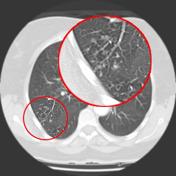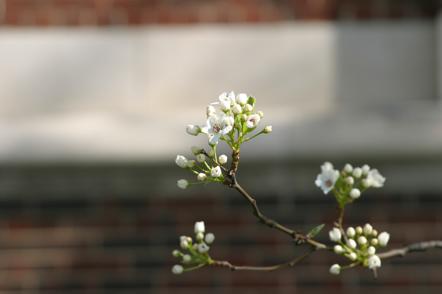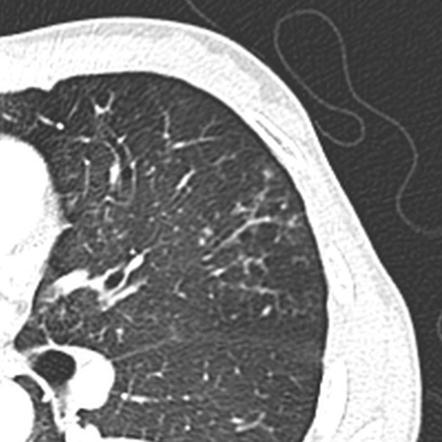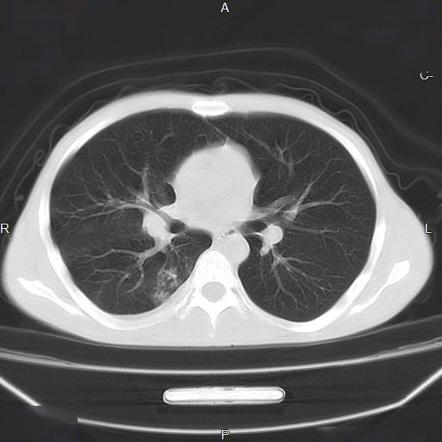tree in bud lesion
Multiple causes for tree-in-bud TIB opacities have been reported. The tree-in-bud pattern is commonly seen at thin-section computed tomography CT of the lungs.

Tree In Bud Sign Lung Radiology Reference Article Radiopaedia Org
Tree-in-bud sign refers to the condition in which small centrilobular nodules less than 10 mm in diameter are associated with centrilobular branching nodular structures 1 Fig.

. The tree-in-bud sign could be seen in various infectious diseases including endobronchial spread of tuberculosis bacterial viral parasitic and fungal. Generally these often result in bronchial wall thickening with replacement of the. Histopathologic analysis confirmed that the tree-in-bud lesions were caused by arterial embolization of primary neoplastic cells from an osteosarcoma.
The remaining pulmonary parenchyma demonstrated scattered tree-in-bud pattern with lower lobe predominance and without pleural effusion. The tree-in-bud sign on thin-section CT is characterized by well-defined small centrilobular nodules and linear opacities with multiple branching sites thus resembling a budding tree in spring. This finding is considered classical for endobronchial TB as in this case.
We filled the cavity with saline under direct bronchoscopic visualization. A 28yearold man had a cavitary lesion in the upper right lobe with a treeinbud appearance on chest computed tomography CT. The tree-in-bud sign indicates bronchiolar luminal impaction with mucus pus or fluid causing normally invisible peripheral airways to become visible 80.
There are no criteria for invasion of the aorta or the bronchial tree. The impression at the end said a focus of bronchitis and bronchiolitis. Originally reported in cases of endobronchial spread of Mycobacterium tuberculosis this.
The associated central bronchi are impacted. Based on lesion localization and presence or suspicion of a concomitant bronchial disease for cats in this sample authors propose that the CT treeinbud pattern described in humans is also a characteristic of bronchial or bronchiolar plugging and bronchial disease in cats. We investigated the pathological basis of the tree-in-bud lesion by reviewing the pathological specimens of bronchograms of normal lungs and contract radiographs of the post-mortem lungs manifesting active pulmonary tuberculosis.
The patient died 15 days after CT was performed. The tree-in-bud pattern seen on CT represents radiologic sequelae of an infectious or in ammatory process. 78 indicating the absenceresolution of tib opacities 26 incomplete thoracic ct scan studies 75 duplicate individuals two insuffi cient.
The small nodules represent lesions involving the small airways. Lymph node involvement at the carina level were noted. Histopathology The tree-in-bud pattern seen on CT represents radiologic sequelae of an infectious or inflammatory process.
As a result involved bronchioles are more conspicuous on computed tomography imaging. CT scan shows Tree in Bud lesions showing an appearance of multiple areas of centrilobular nodules with a linear branching pattern. The purpose of this study was to determine the relative frequency of causes of TIB opacities and identify patterns of disease associated with TIB opacities.
Endobronchial tuberculosis the tree-in-bud lesions consist of either endo-luminal caseum or mixture of intra- and peri-bronchiolar caseation inflammatory cells and debris fibrosis and granuloma formation. The tree-in-bud sign has been described in cases of acute aspiration 13. Diagnostic bronchoscopy was performed.
Intravascular pulmonary tumor embolism often occurs in cancers of the breast liver kidney stomach prostate and ovaries and can lead to the tree-in-bud sign in HRCT 214. Malignancy can be associated with the tree-in-bud sign. Tuesday May 12 2020 chest radiology CXR.
The tree-in-bud tomographic pattern is caused by centrilobular branching structures that appear similar to a budding tree. Click to see full answer. Is a radiological sign that characterises abnormal filling and stretching of the bronchioles best seen in the periphery of the lung AND and localises the disease to the centrilobular bronchioles.
Generally these often result in bronchial wall thickening with replacement of the normally air-filled lumen with mucous or pus. This is 13 year old child with mother who is sputum positive for TB. It consists of small centrilobular nodules of soft-tissue attenuation connected to multiple branching linear structures of similar caliber that originate from a single stalk.
There is lack of tapering at the tip of their branches giving the appearnce of knobbybulbous branches and hence the budding reference. It is not specific for a single disease entity but is a direct sign of various diseases of the peripheral airways and an indirect sign of bronchiolar diseases such as air trapping or sub-segmental consolidation. Tree in bud opacification refers to a sign on chest ct where small centrilobular nodules and corresponding small branches simulate the appearance of the end of a branch belonging to a tree that is in bud.
Earliest findings of endobronchial spread tuberculosis mostly from adjacent cavity is the formation of intrabronchiolar caseum. Situations the tree-in-bud appearance can be a result of di- lated peripheral centrilobular artery filled with intravascular tumor emboli or thrombotic microangiopathy of tumors rep- resenting the hematogenous spread of pulmonary metasta- sis 6 7. Tree in Bud Appearance.
Volume59 Issue1 JanuaryFebruary 2018 Pages32-42 Related Information. However vascular lesions involving the arterioles and capillaries may simulate the centrilobular small nodules and. An ultrathin bronchoscope in the right B2aiiβxyy reached the cavity.
The patient had an oesophageal lesion below the carina extending longitudinally 6 cm. Centrilobular nodules with a linear branching pattern are consistent with tree-in-bud appearance in a patient with endobronchial spreading of post-primary tuberculosis. However to our knowledge the relative frequencies of the causes have not been evaluated.
The tree-in-bud-pattern of images on thin-section lung CT is defined by centrilobular branching structures that resemble a budding tree. Hi doctor My CT scan says defined streaky opacity with associated loss volume and clustered tree in bud nodules have developed in the anterior segment of the upper left lobe. Without an obvious mass although a small central lesion is not excluded.

References In Causes And Imaging Patterns Of Tree In Bud Opacities Chest

References In Causes And Imaging Patterns Of Tree In Bud Opacities Chest

Tree In Bud Sign Marking Advancing Cavitary Tb A 4 Mm Coronal Ct Download Scientific Diagram
View Of Tree In Bud The Southwest Respiratory And Critical Care Chronicles

Tree In Bud Pattern Pulmonary Tb Eurorad

Cylindrical Bronchiectasis And Tree In Bud Pattern In Lower Lobes And Download Scientific Diagram

Tree In Bud Sign Lung Radiology Reference Article Radiopaedia Org

Tree In Bud Pattern Pulmonary Tb Eurorad
View Of Tree In Bud The Southwest Respiratory And Critical Care Chronicles

Tree In Bud Sign Lung Radiology Reference Article Radiopaedia Org

Co Rads 2 With Tree In Bud Sign A 27 Year Old Male Attended The Download Scientific Diagram

Tree In Bud Sign Lung Radiology Reference Article Radiopaedia Org

Tree In Bud Sign Lung Radiology Reference Article Radiopaedia Org
